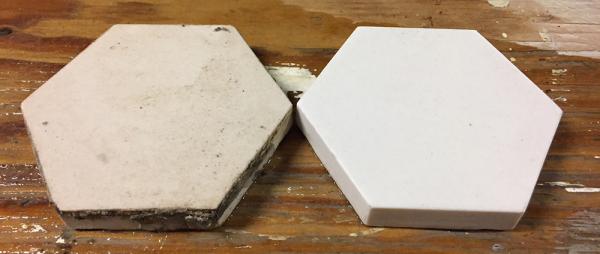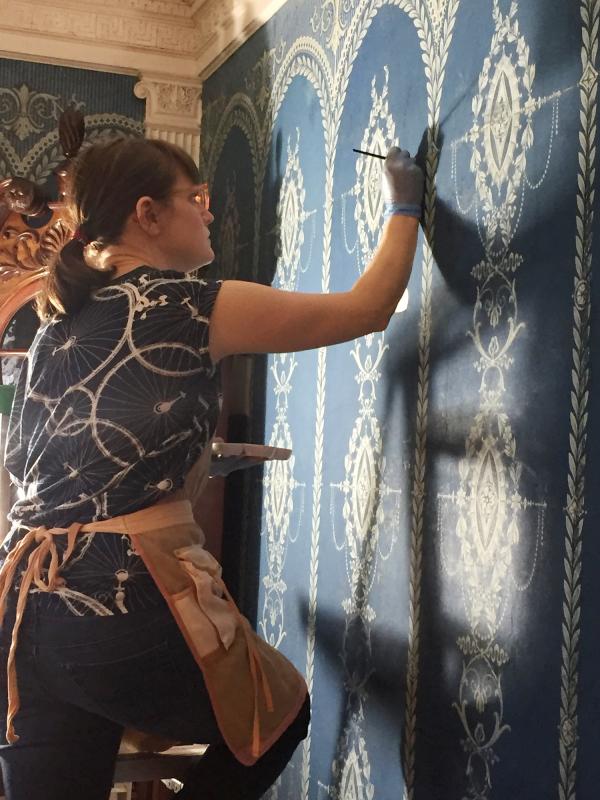Fascinating article. Thank you for sharing all that you do to keep the intergrity of the Inn in tact. We are so grateful for your thoughtful efforts!
On Plumbing and Preservation
Water leaks and stains are something to be feared in a historic house. In late June of 2017, we began noticing a few damp spots on the historic Fr. Beck & Co. blue wallpaper covering the corridor walls leading to the Main Dining Room. The problem seemed isolated, so Wally Allen, Buildings and Grounds Manager, monitored these areas with a moisture meter throughout the summer into the fall. The dark areas remained slightly damp but, fortunately, the size of the spots didn’t expand.
After we closed for the season, we investigated the plumbing and pipes with a camera, and discovered that the original plumbing stack connected to the Rose and Louis bathrooms was leaking ever so slightly. To replace the whole stack and make necessary repairs, we had to expose the plumbing located behind the historic wallpaper, buried beneath the plaster wall, and sandwiched between brick (for soundproofing). We’d also have to access pipes beneath the original floors in both bathrooms.
In a typical residential project, you’d tear out the sheetrock, pull up the tiles, replace the pipe, and install fresh everything, maybe upgrading some fixtures while you’re at it. (Home repairs are a chance to redecorate, right?)
But as an integral piece of a National Historic Landmark and a public guesthouse, the Inn is not your average home. And as stewards of its historic (original) fabric and features, we approach every repair very thoughtfully.
The National Park Service outlines guidelines for the treatment of historic properties, ranging from the least invasive approaches to the most: preservation, rehabilitation, restoration and reconstruction. These approaches provide standards and considerations for the type of work necessary based on the property and its use. In order to maintain a high degree of historic integrity, we, more often, rely on integrated approaches, using both preservation and restoration.
Take the original Fr. Beck blue wallpaper, which dates to 1899. We knew we’d have to remove at least three vertical panels to safely get to the pipe. What was the best approach? I researched several options ranging from careful removal and conservation of the existing compromised wallpaper to having digital or hand-screened copy made by a company that specializes in reproductions of 19th and 20th century wallpapers. We chose to have the original three panels removed from the wall and conserved. This is a great example of a preservation project!
With the wallpaper safely removed, a section of the pristine plaster wall from 1899 was revealed. We penetrated through layers of plaster and brick and finally--the pipe! Once the pipe repair was complete, all layers of plaster and brick were replaced.
Related work on the second floor of the Inn posed equally vexing questions about preservation. Some of the original wall tiles and all the original porcelain floor tiles in both the Louis and Rose bathrooms were removed to access more pipes. Some of the subway wall tiles were cracked and broken, and would need to be replaced. To retain the historic integrity of the house, we used a similar, but not exact tile match to replace only the compromised tiles.
The floor tiles were both easier -- and harder -- to deal with. Fortunately, white, hexagonal, porcelain tile had been used in nearly all the Inn bathroom floors, and in some service spaces (like the kitchen). Last year, during the kitchen restoration project, we salvaged nearly all of these tiles. This year, we also saved as much of the bathroom tile as we could. With this good supply of original tile, it seemed prudent to attempt to clean and reuse them for the bathroom project. Based on square footage, we needed 3,000 tile. But each one needed to be cleaned by hand! In February we began the process of cleaning 3,000 tiles. Thanks to volunteers, we succeeded!
The results are an historic home that has lost a tiny bit -- but retained so much -- of its historic fabric. And while the vigorous debates that we have around preservation or restoration, etc. for any given project can seem a bit esoteric, what’s at stake is not each decision in isolation, but their cumulative impact on the historic integrity of the house.
Update:
Rehanging Conserved Wallpaper in No Man’s Land Corridor
Our four-month project to preserve damaged sections of original wallpaper culminated on May 12th. Three vertical panels (and three border panels) of historic Frederick Beck & Co. wallpaper were rehung in the corridor by the Marble Dining Room. Fr(ederick). Beck & Co., established in 1860, was one of the premier designers and manufacturers of artistic wallpapers in America.
John Plant, a master wallpaper hanger, worked with conservator Carolyn Frisa on the re-installation. While Carolyn conserves wallpaper, she is adamant that she is not a hanger! The project could not have been successful without their collective knowledge and experience.
Comments
Fantastic work on the wallpaper, plumbing and tile! My wife and I stayed in the Rose Room last year (or the year before? time flies) and I remember the floor tile issues. Keep up the remarkable attention to preservation issues - the house and the mission are the better for it.
Mac Collins
South Freeport, Maine
Amazing team work!










